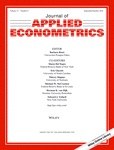
Dobbelaere, S. and Mairesse, J. (2013). Panel data estimates of the production function and product and labor market imperfections Journal of Applied Econometrics, 28(1):1--46.
-
Affiliated author
-
Publication year2013
-
JournalJournal of Applied Econometrics
Consistent with two models of imperfect competition in the labor market-the efficient bargaining model and the monopsony model-we provide two extensions of a microeconomic version of Hall's framework for estimating price-cost margins. We show that both product and labor market imperfections generate a wedge between factor elasticities in the production function and their corresponding shares in revenue, which can be characterized by a 'joint market imperfections parameter'. Using an unbalanced panel of 10,646 French firms in 38 manufacturing industries over the period 1978-2001, we can classify these industries into six different regimes depending on the type of competition in the product and the labor market. By far the most predominant regime is one of imperfect competition in the product market and efficient bargaining in the labor market (IC-EB), followed by a regime of imperfect competition in the product market and perfect competition or right-to-manage bargaining in the labor market (IC-PR), and by a regime of perfect competition in the product market and monopsony in the labor market (PC-MO). For each of these three predominant regimes, we assess within-regime firm differences in the estimated average price-cost mark-up and rent sharing or labor supply elasticity parameters, following the Swamy methodology to determine the degree of true firm dispersion. To assess the plausibility of our findings in the case of the dominant regime (IC-EB), we also relate our industry and firm-level estimates of price-cost mark-up and extent of rent sharing to industry characteristics and firm-specific variables respectively. {\textcopyright} 2011 John Wiley \& Sons, Ltd.